推荐等级:
发布时间: 2021-06-25 14:26
扫码用手机做题
Here's how the Pacific Northwest is preparing for "The Big One". It's the mother of all disaster drills for what could be the worst disaster in American history. California has spent years preparing for "The Big One" -- the inevitable earthquake that will undoubtedly unleash all kinds of havoc along the famous San Andreas fault (断层). But what if the fault that runs along the Pacific Northwest delivers a gigantic earthquake of its own? If the people of the Cascadia region have anything to do with it, they won't be caught unawares.
The region is engaged in a multi-day earthquake-and-tsunami(海啸) drill involving around 20,000 people. The Cascadia Rising drill gives area residents and emergency responders a chance to practice what to do in case of a 9.0-magnitude earthquake and tsunami along one of the nation's dangerous -- and underestimated -- faults.
The Cascadia Earthquake Zone is big enough to compete with San Andreas (it's been called the most dangerous fault in America), but it's much lesser known than its California cousin. Nearly 700 miles long, the earthquake zone is located by the North American Plate off the coast of Pacific British Columbia, Washington, Oregon and Northern California.
Cascadia is what's known as a "megathrust" fault. Megathrusts are created in earthquake zones-land plate boundaries where two plates converge. In the areas where one plate is beneath another, stress builds up over time. During a megathrust event, all of that stress releases and some of the world's most powerful earthquakes occur. Remember the 9.1 earthquake and tsunami in the Indian Ocean off Sumatra in 2004? It was caused by a megathrust event as the India plate moved beneath the Burma micro-plate.
The last time a major earthquake occurred along the Cascadia fault was in 1700, so officials worry that another event could occur any time. To prevent that event from becoming a catastrophe, first responders will join members of the public in rehearsals that involve communication, evacuation, search and rescue, and other scenarios.
Thousands of casualties are expected if a 9.0 earthquake were to occur. First, the earthquake would shake metropolitan areas including Seattle and Portland. This could trigger a tsunami that would create havoc along the coast. Not all casualties can necessarily be prevented -- but by coordinating across local, state, and even national borders, officials hope that the worst-case scenario can be averted. On the exercise's website, officials explain that the report they prepare during this rehearsal will inform disaster management for years to come.
For hundreds of thousands of Cascadia residents, "The Big One" isn't a question of if, only when. And it's never too early to get ready for the inevitable.
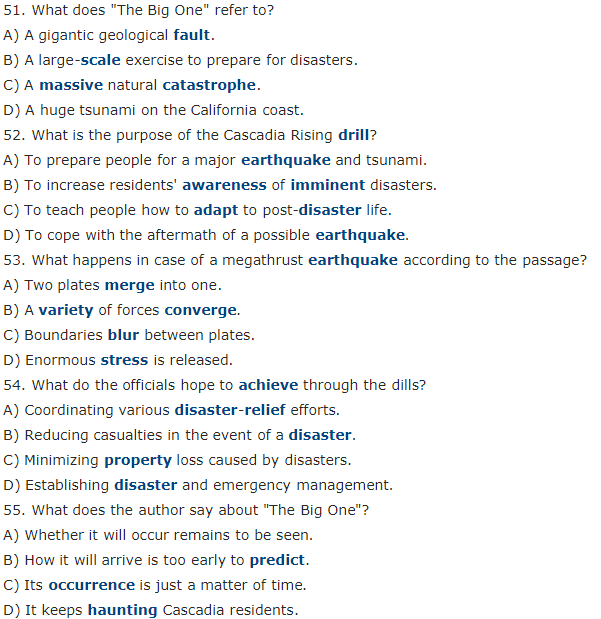
51.C 52.A 53.D 54.B 55.C
本题解析:暂无解析
"The dangerous thing about lying is people don't understand how the act changes us," says Dan Ariely, behavioral psychologist at Duke University. Psychologists have documented children lying as early as the age of two. Some experts even consider lying a developmental milestone, like crawling and walking, because it requires sophisticated planning, attention and the ability to see a situation from someone else's perspective to manipulate them. But, for most people, lying gets limited as we develop a sense of morality and the ability to self-regulate.
Harvard cognitive neuroscientist Joshua Greene says. for most of us, lying takes work. In studies, he gave subjects a chance to deceive for monetary gain while examining their brains in a functional MRI machine,which maps blood flow to active parts of the brain. Some people told the truth instantly and instinctively. But others opted to lie, and they showed increased activity in their frontal parietal (颅腔壁的) control network, which is involved in difficult or complex thinking. This suggests that they were deciding between truth and dishonesty and ultimately opting for the latter. For a follow-up analysis, he found that people whose neural(神经的)reward centres were more active when they won money were also more likely to be among the group of liars- suggesting that lying may have to do with the inability to resist temptation.
Extremal conditions also matter in terms of when and how often we lie. We are more likely to lie, research shows, when we are able to rationalise it, when we are stressed and fatigued or sec others being dishonest. And we are less likely to lie when we have moral reminders or when we think others are watching. "We as a society need to understand that, when we don't punish lying, we increase the probability it will happen again," Ariely says.
In a 2016 study published in the journal Nature Neuroscience, Ariely and colleagues showed how dishonesty alters people's brains, making it easier to tell lies in the future. When people uttered a falsehood, the scientists noticed a burst of activity in their amygdala. The amygdala is a crucial part of the brain that produces fear, anxiety and emotional responses including that sinking, guilty feeling you get when you lie. But when scientists had their subjects play a game- in which they won money by deceiving their partner, they noticed the negative signals from the amygdala began to decrease. Not only that, but when people faced no consequences for dishonesty, their falsehoods tended to get even more sensational. This means that if you give people multiple opportunities to lie for their own benefit, they start with little lies which get bigger over time.
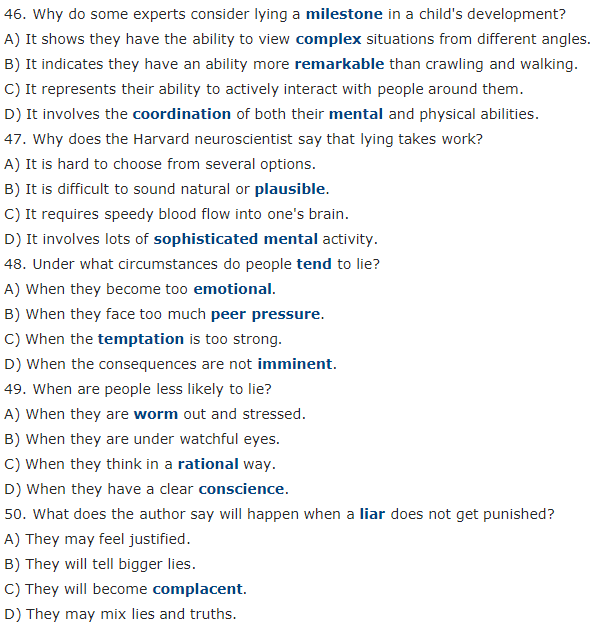
46.A 47.D 48.B 49.B 50.B
本题解析:暂无解析
A) Have young people never had it so good? Or do they face more challenges than any previous generation? Our current era in the West is one of high wealth. This means minors enjoy material benefits and legal protections that would have been the envy of those living in the past. But There is an increasing suspicion that all is not well for our youth. And one of the most popular explanations, among some experts and the popular media, is that excessive "screen time" is to blame. (This refers to all the attention young people devote to their phones, tablets and laptops.) However, this is a contentious theory and such claims have been treated skeptically by some scholars based on their reading of the relevant data.
B) Now a new study has provided another contribution to the debate, uncovering strong evidence that adolescent wellbeing in the United States really is experiencing a decline and arguing that the most likely cause is the electronic riches we have given them. The background to this is that from the 1960s into the early 2000s, measures of average wellbeing went up in the US. This was especially true for younger people. It reflected the fact that these decades saw a climb in general standards of living and avoidance of mass societal traumas like full-scale war or economic deprivation. However, the "screen time" hypothesis, advanced by researchers such as Jean Twenge, is that electronic devices and excessive time spent online may have reversed these trends in recent years, causing problems for young people's psychological health.
C) To investigate, Twenge and her colleagues dived into the "Monitoring the Future" dataset based on annual surveys of American school students from grades 8, 10, and 12 that started in 1991. In total, 1.1 million young people answered various questions related to their wellbeing. Twenge's team's analysis of the answers confirmed the earlier, well-established wellbeing climb, with scores rising across the 1990s, and into the later 2000s,This was found across measures like self-esteem, life satisfaction, happiness and satisfaction with individual domains like job, neighborhood, or friends. But around 2012 these measures started to decline. This continued through 2016, the most recent year for which data is available.
D) Twenge and her colleagues wanted to understand why this change in average wellbeing occurred. However, it is very hard to demonstrate causes using non-experimental data such as this. In fact, when Twenge previously used this data to suggest a screen time effect, some commentators were quick to raise this problem. They argued that her causal-sounding claims rested on correlational data, and that she had not adequately accounted for other potential causal factors. This time around, Twenge and her team make a point of saying that they are not trying to establish causes as such, but that they are assessing the plausibility of potential causes.
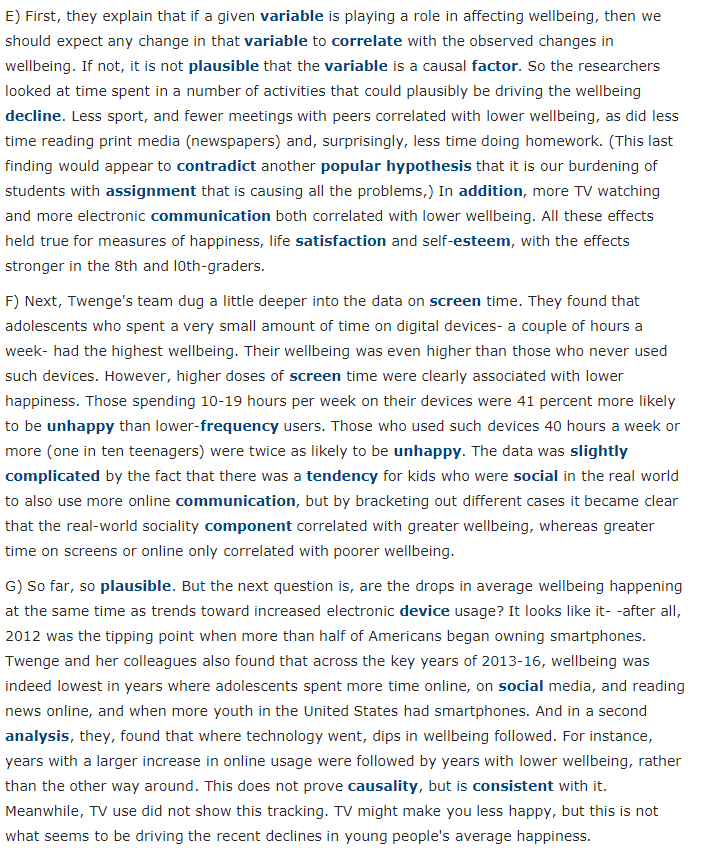
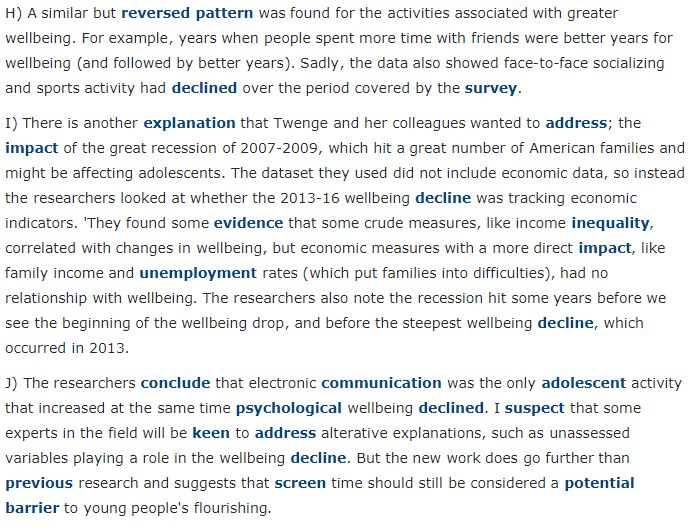
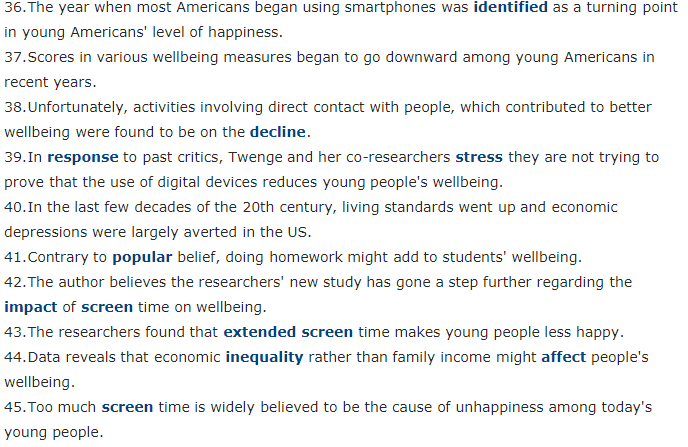
36.G 37.C 38.H 39.D 40.B 41.E 42.J 43.F 44.I 45.A
本题解析:暂无解析
When considering risk factors associated with serious chronic diseases, we often think about health indicators such as cholesterol, blood pressure, and body weight. But poor diet and physical inactivity also each increase the risk of heart disease and have a role to play in the development of some cancers. Perhaps worse, the __26__ effects of an unhealthy diet and insufficient exercise are not limited to your body. Recent research has also shown that __27__ in a high-fat and high-sugar diet may have negative effects on your brain, causing learning and memory __28__.
Studies have found obesity is associated with impairments in cognitive functioning, as __29__ by a range of learning and memory tests, such as the ability to remember a list of words presented some minutes or hours earlier. There is also a growing body of evidence that diet induced cognitive impairments can emerge __30__ within weeks or even days. For example, one study found healthy adults __31__ to a high-fat diet for five days showed impaired attention, memory, and mood compared with a low-fat diet control group. Another study also found eating a high-fat and high-sugar breakfast each day for as little as four days resulted in problems with learning and memory __32__ to those observed in overweight and obese individuals.
Body weight was not hugely different between the groups eating a healthy diet and those on high and sugar diets. So this shows negative __33__ of poor dietary intake can occur even when body weight has not changed __34__. Thus, body weight is not always the best indicator of health and a thin person still needs to eat well and exercise __35__.
A)assessed B)assigned C)consequences D)conspicuously E)deficits F)designated G)detrimental H)digestion I)excelling J)indulging K)loopholes L)rapidly M)redundant N)regularly O)similar
26.G 27.J 28.E 29.A 30.L 31.B 32.O 33.C 34.D 35.N
本题解析:暂无解析
For this part, you are allowed 30 minutes to write an essay on the importance of having a sense of social responsibility. You should write at least 150 words but no more than 200 words.
Problems such as the violation of privacy and environmental pollution are becoming increasingly prevalent in modern society. To some extent, they can be ascribed to a distinct lack of a sense of social responsibility among enterprises and individuals, which is of crucial importance in building a better world.
When seeking profits, socially responsible corporations never forget to make positive contributions to our society. Take Alibaba, a leading tech company in China. The Ant Forest green initiative it launched in 2016 has so far inspired up to 500 million Alipay users to adopt low-carbon lifestyles and resulted in over 100 million trees planted in China's most barren regions. At the individual level, a sense of social responsibility motivates us college students to acquire as much knowledge as possible and put it into practice. It also prevents us from engaging in unethical behaviors such as campus violence and academic misconduct that cause negative social impacts.
To sum up, a healthy society requires all its members to take on their respective responsibilities. Everyone, therefore, should develop a sense of social responsibility, especially we college students who will be a pillar of society in the future.
本题解析:
侵犯隐私权、污染环境等问题在现代社会日益普遍。在某种程度上,这可以归咎于企业和个人明显缺乏社会责任感,这对于建设一个更美好的世界至关重要。
在追求利润的同时,具有社会责任感的企业永远不会忘记为我们的社会做出积极的贡献。以中国领先的科技公司阿里巴巴为例。2016年发起的“蚂蚁森林绿色行动”迄今已激励了多达5亿支付宝用户采用低碳生活方式,并在中国最贫瘠的地区种植了超过1亿棵树。在个人层面,社会责任感促使我们大学生尽可能多地获取知识并付诸实践。它也防止我们从事不道德的行为,如校园暴力和学术不端行为,造成负面的社会影响。
总而言之,一个健康的社会需要它的所有成员承担起各自的责任。因此,每个人都应该培养一种社会责任感,特别是我们大学生,他们将成为未来社会的栋梁。
梅花(plum blossom)位居中国十大名花之首,源于中国南方,已有三千多年的栽培和种植历史。隆冬时节,五颜六色的梅花不畏严寒,迎着风雪傲然绽放。在中国传统文化中,梅花象征着坚强、纯洁、高雅、激励人们不畏艰难、砥砺前行。自古以来,许多诗人和画家从梅花中获取灵感,创作了无数不朽的作品。普通大众也都喜爱梅花,春节期间常用于家庭装饰。南京市已将梅花定为市花,每年举办梅花节,成千上万的人冒着严寒到梅花山踏雪赏梅。
The plum blossom, the king of China's top ten famous flowers, originated in southern China and has been cultivated for over 3000 years. In the depths of winter, colorful plum blossoms bloom vibrantly amidst the wind and snow, unhindered by severe frost. The plum blossom, a symbol of strength, purity and elegance in traditional Chinese culture, motivates people to brave hardship and forge ahead. Since ancient times, many poets and painters have been drawing inspirations from plum blossoms and created countless immortal works. Plum blossoms are also very popular with the general public and often used as home decoration during the Spring Festival. Nanjing has designated the plum blossom as the city flower and holds the Plum Blossom Festival each year, which attracts thousands of people to Plum Blossom Hill to enjoy the full bloom in the snow irrespective of the severe cold.
本题解析:暂无解析
Industrial fishing for krill(磷虾) in the unspoilt waters around Antarctica is threatening the future of one of the world's last great wildernesses, according to a new report.
The study by Greenpeace analysed the movements of krill fishing vessels in the region and found they were increasingly operating "in the immediate vicinity of penguin colonies and whale feeding grounds". It also highlights incidents of fishing boats being involved in groundings, oil spills and accidents, which posed a serious threat to the Antarctic ecosystem.
The report, published on Tuesday, comes amid growing concern about the impact of fishing. and climate change on the Antarctic. A global campaign has been launched to create a network of ocean sanctuaries to protect the seas in the region and Greenpeace is calling for an immediate halt to fishing in areas being considered for sanctuary status.
Frida Bengtsson from Greenpeace's Protect the Antarctic campaign said: "If the krill industry wants to show it's a responsible player, then it should be voluntarily getting out of any area which is being proposed as an ocean sanctuary, and should instead be backing the protection of these huge tracts of the Antarctic."
A global campaign has been launched to turn a huge tract of Antarctic seas into ocean sanctuaries, protecting wildlife and banning not just krill fishing, but all fishing. One was created in the Ross Sea in 2016, another reserve is being proposed in a vast area of the Weddell Sea, and a third sanctuary is under consideration in the area west of the Antarctic Peninsula -- a key krill fishing area.
The Commission for the Conservation of Antarctic Marine Living Resources (CCAMLR) manages the seas around Antarctica. It will decide on the Weddell Sea sanctuary proposal at a conference in Australia in October, although a decision on the peninsula sanctuary is not expected until later.
Keith Reid, a science manager at CCAMLR, said that the organisation sought "a balance between protection, conservation and sustainable fishing in the Southern Ocean." He said although more fishing was taking place nearer penguin colonies it was often happening later in the season when these colonies were empty.
"The creation of a system of marine protected areas is a key part of ongoing scientific and policy discussions in CCAMLR," he added. "Our long-term operation in the region depends on a healthy and thriving Antarctic marine ecosystem, which is why we have always had an open dialogue with the environmental non-governmental organisations. We strongly intend to continue this dialogue, including talks with Greenpeace, to discuss improvements based on the latest scientific data. We are not the ones to decide on the establishment of marine protected areas, but we hope to contribute positively with our knowledge and experience."
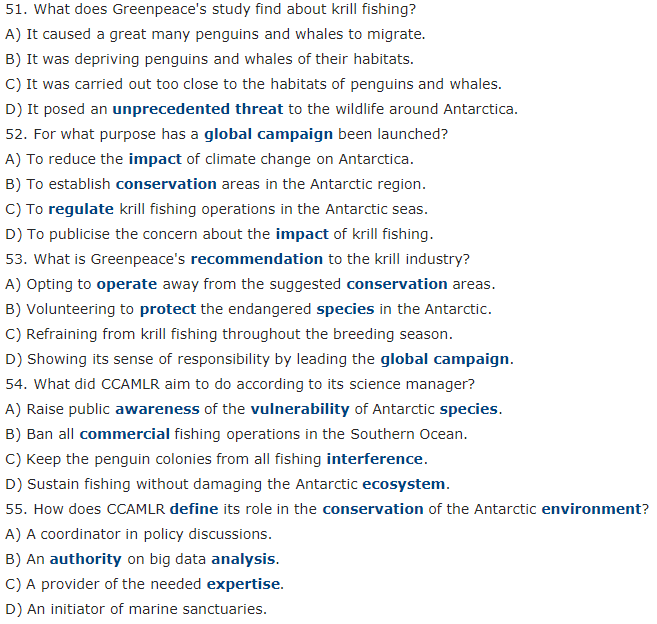
51.C) It was carried out too close to the habitats of penguins and whales.
52.B) To establish conservation areas in the Antarctic region.
53.A) Opting to operate away from the suggested conservation areas.
54.D) Sustain fishing without damaging the Antarctic ecosystem.
55.C) A provider of the needed expertise.
本题解析:暂无解析
Last year, a child was born at a hospital in the UK with her heart outside her body. Few babies survive this rare condition, and those who do must endure numerous operations and are likely to have complex needs. When her mother was interviewed, three weeks after her daughter's birth, she was asked if she was prepared for what might be a daunting (令人生畏的) task caring for her. She answered without hesitation that, as far as she was concerned, this would be a "privilege".
Rarely has there been a better example of the power of attitude, one of our most powerful psychological tools. Our attitudes allow us to turn mistakes into opportunities, and loss into the chance for new beginnings. An attitude is a settled way of thinking, feeling and/or behaving towards particular objects, people, events or ideologies. We use our attitudes to filter, interpret and react to the world around us. You weren't born with attitudes, rather they are all learned, and this happens in a number of ways.
The most powerful influences occur during early childhood and include both what happened to you directly, and what those around you did and said in your presence. As you acquire a distinctive identity, your attitudes are further refined by the behavior of those with whom you identify -- your family, those of your gender and culture, and the people you admire, even though you may not know them personally. Friendships and other important relationships become increasingly important, particularly during adolescence. About that same time and throughout adulthood, the information you receive, especially when ideas are repeated in association with goals and achievements you find attractive, also refines your attitudes.
Many people assume that our attitudes are internally consistent, that is, the way you think and feel about someone or something predicts your behavior towards them. However, may studies have found that feelings and thoughts don't necessarily predict behavior. In general, your attitudes will be internally consistent only when the behavior is easy, and when those around you hold similar beliefs. That's why, for example, may say they believe in the benefits of recycling or exercise, but don't behave in line with their views, because it takes awareness, effort and courage to go beyond merely stating that you believe something is a good idea.
One of the most effective ways to change an attitude is to start behaving as if you already feel and think the way you'd prefer to. Take some time to reflect on your attitudes, to think about what you believe and why. Is there anything you consider a burden rather than a privilege? It so, start behaving -- right now -- as if the latter is the case.
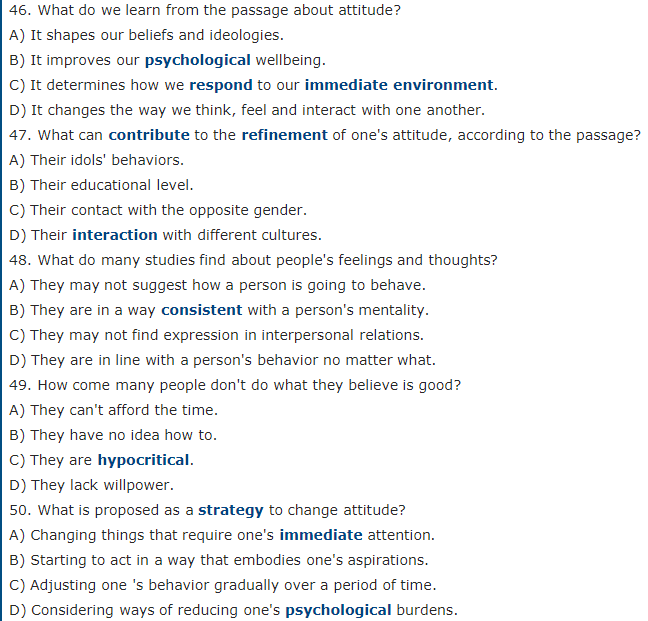
46.C) It determines how we respond to our immediate environment.
47.A) Their idols' behaviors.
48.A) They may not suggest how a person is going to behave.
49.D) They lack willpower.
50.B) Starting to act in a way that embodies one's aspirations.
本题解析:暂无解析
A) The marketing is tempting: Get stronger muscles and healthier bodies with minimal effort by adding protein powder to your morning shake or juice drink. Or grab a protein bar at lunch or for a quick snack. Today, you can find protein supplements everywhere -- online or at the pharmacy, grocery store or health food store. They come in powders, pills and bars. With more than $12 billion in sales this year, the industry is booming and, according to the market research company, Grand View Research, is on track to sell billions more by 2025. But do we really need all this supplemental protein? It depends. There are pros, cons and some other things to consider.
B) For starters, protein is critical for every cell in our body. It helps build nails, hair, bones and muscles. It can also help you feel fuller longer than eating foods without protein. And, unlike nutrients that are found only in few foods, protein is present in all foods. "The typical American diet is a lot higher in protein than a lot of us think," says registered dietitian Angela Pipitone. "'It's in foods many of us expect, such as beef, chicken and other types of meat and dairy. But it's also in foods that may not come immediately to mind like vegetables, fruit, beans and grains."
C) The U.S. government 's recommended daily allowance (RDA) for the average adult is 50 to 60 gram of protein a day. This may sound like a lot, but Pipitone says: "We get bits of protein here and there and that really adds up throughout the day." Take, for example. breakfast. If you eat two eggs topped with a little bit of cheese and an orange on the side, you already have 22 grams of protein. Each egg gives you 7 grams, the cheese gives you about 6 grams and the orange -- about 2 grams. Add a lunch of chicken, rice and broccoli(西兰花), and you are already over the recommended 50 grams. "You can get enough protein and meet the RDA before you even get to dinner," says Pipitone.

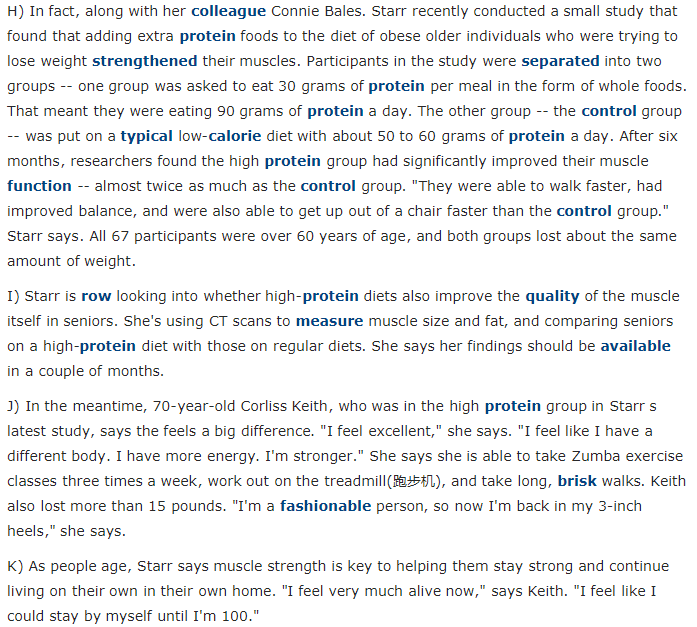
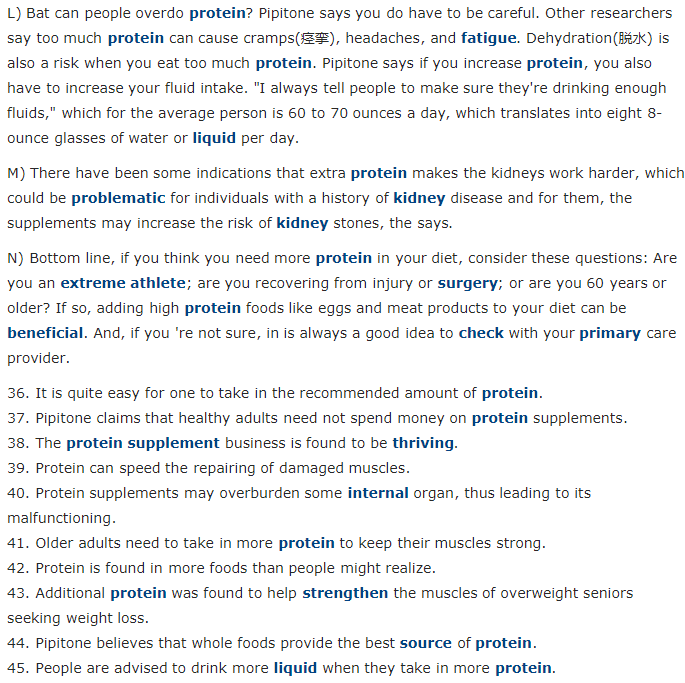
36.C 37.E 38.A 39.F 40.M 41.G 42.B 43.H 44.D 45.L
本题解析:暂无解析
试卷分类:大学英语六级
练习次数:1次
试卷分类:大学英语四级
练习次数:2次
试卷分类:大学英语六级
练习次数:0次
试卷分类:大学英语四级
练习次数:1次
试卷分类:大学英语六级
练习次数:2次
试卷分类:大学英语四级
练习次数:2次
试卷分类:大学英语六级
练习次数:0次
试卷分类:大学英语四级
练习次数:0次
试卷分类:大学英语四级
练习次数:2次
试卷分类:大学英语四级
练习次数:0次